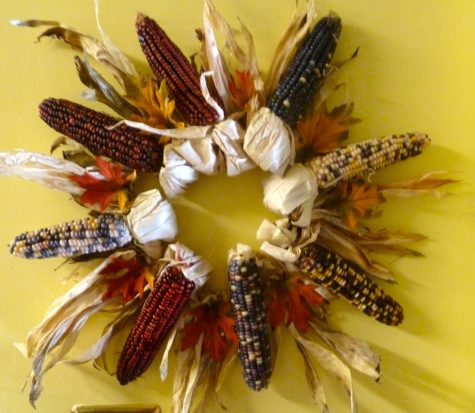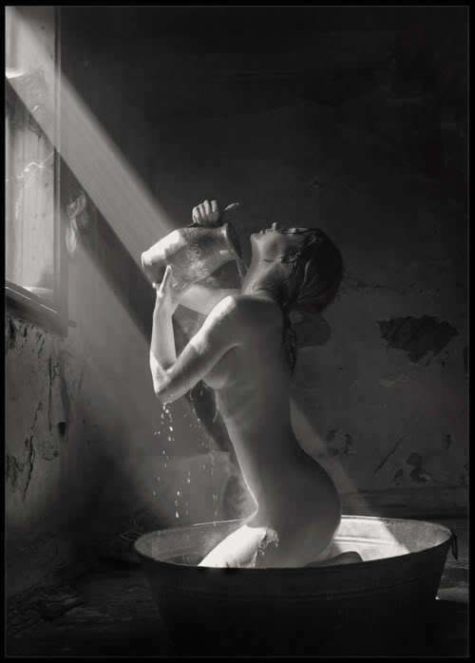Monthly Archives: July 2017
You can create a Solar Wheel or a Corn Man Wheel using a wire coat hanger, cardboard, and several ears of Indian corn complete with the husks.
Magickal Uses:
The wheel can then be used to decorate your altar, or you could hang it on your door as a decoration and a celebration of the wheel of the year. Corn is a symbol of fertility, and a Solar Wheel invokes the power of the Sun to bring health and happiness to your home.
Here is how to make it:
- Bend a wire hanger into a circle keeping the hook to hang it by.
- Cut out a small cardboard circle to glue the tips of the ears of corn onto.
You may want to create your Corn Man Wheel as a pentagram using five ears, or a Solar Wheel using eight ears to represent one ear for each Sabbat.
- Attach the ears of Indian corn around the perimeter of the wire circle.
- Wrap the husks around and glue where necessary, leave some of the husks hanging loose to fray out from the edges and make it more decorative.
- Where the ears of corn meet in the center, glue them together. This is where the cardboard circle comes in to use.
- Sprigs of wheat, dried flowers, and herbs can be used as decorative filler between the ears of corn.
Here are a variety of different wheels and wreaths that can be made to celebrate the season and the Corn.
And this is a simple idea to gift back to the wild ones who live all around us.

- 20 drops clove bud oil
- 25 drops sandalwood oil
- 1 cup oak moss
- 2 cups dried pink rosebuds
- 2 cups dried red peony petals
- 1 cup dried amaranth flowers
- 1 cup dried heather flowers
Mix the clove bud and sandalwood oils with the oak moss and then add the remaining ingredients. Stir the potpourri well and store in a tightly covered ceramic or glass container.
From: The Wicca Spellbook
- 2 parts Frankincense
- 1 part Heather
- 1 part Apple blossoms
- 1 pinch Blackberry leaves
- a few drops Ambergris oil
Burn Lughnasadh Incense during Wiccan rituals on August 1st or 2nd, or at that time to attune with the coming harvest.
Once upon a time, this formula was a mainstay of folk healers, who used it to treat anemia. Although its medical uses are no longer popular, this remains a very important formula.
War water is used for:
- To gain protection. This is a very aggressive, forceful, spiritual cleanser.
- To reverse a curse and send it back where it came from.
- To place a curse. War Water is a traditional and allegedly potent weapon during psychic warfare and witch wars.
War water can be used in:
- Bath spells
- Floor washes
- To splash on a door step or other target.
- It can also be added to or used in spell work for protection, cleansing, reversal spells, hex work and more.
How to make simple standard Protective War Water:
Place iron nails in a mason jar. Cut iron nails are recommended because they rust very easily, but any iron nails may be used. Add enough water to cover the nails. Leave this undisturbed until rust begins to form, typically within seven to ten days. Although the jar is usually kept shut, it should be opened periodically to encourage oxidation.
Once the rusting process begins, more water may be added. Keep the jar in a refrigerator or other cool area. Stir as needed.
You may continue adding water to the original nails virtually indefinitely. Some people have a War Water starter lasting years, akin to a sour dough starter. However, should mold or bacteria ever form, discard everything, including the jar and start again from the beginning.
How to make simple standard Malevolent War Water:
- Collect water from a fierce thunderstorm in a jar.
- Add rusty nails, sulfur, and some of your own urine.
- Store this in a cold, dry place until you need it.
This version is used to either place or reverse a hex. The rusted nails from the Protective Formula may be used to create the Malevolent version.
Found in: The Element Encyclopedia of 5000 Spells
The Oils:
- 3 parts Frankincense
- 2 parts Basil
- 2 parts Juniper
- 1/2 part Orange
Color: Red
Uses:
For use in attuning with the element of Fire, or for rituals involving strength, courage, passion, lust, etc.
Note:
The proportions here, though for essential oils, are by parts. One part may equal six drops. Generally speaking, there shouldn’t be more than ten total drops of essential oil per half-cup of bath salts. Experiment to find what works best, and please use only genuine essential oils. You should remember, too, the irritating qualities of some essential oils, and use accordingly.
Bath Salts:
To make bath salts add this oil blend to the recipe found in: Bath Salts Basics
From: The Master Grimoire
The Oils:
- 3 parts Frankincense
- 3 parts Sandalwood
- 2 parts Rosemary
- 1 drop Cloves
Color: White
Uses:
Bathe in this mixture for a heavy psychic cleansing. Splash fresh water over your body after the bath.
Caution:
Do not add more than one drop of clove oil – it can be irritating.
Note:
The proportions here, though for essential oils, are by parts. One part may equal six drops. Generally speaking, there shouldn’t be more than ten total drops of essential oil per half-cup of bath salts. Experiment to find what works best, and please use only genuine essential oils. You should remember, too, the irritating qualities of some essential oils, and use accordingly.
Bath Salts:
To make bath salts add this oil blend to the recipe found in: Bath Salts Basics
From: The Master Grimoire
The Oils:
- 4 parts Patchouli
- 3 parts Cypress
- 1 part Vetivert
Color: Green
Uses:
For use in attuning with the Earth, or for rituals involving money, foundation, stability, creativity, fertility, ecology, etc.
Note:
The proportions here, though for essential oils, are by parts. One part may equal six drops. Generally speaking, there shouldn’t be more than ten total drops of essential oil per half-cup of bath salts. Experiment to find what works best, and please use only genuine essential oils. You should remember, too, the irritating qualities of some essential oils, and use accordingly.
Bath Salts:
To make bath salts add this oil blend to the recipe found in: Bath Salts Basics
From: The Master Grimoire
The Oils:
- 3 parts Rosemary
- 2 parts Myrrh
- 2 parts Sandalwood
- 1 part Frankincense
Color: purple
Uses:
Bathe in Circle Bath before any form of ritual work to strengthen, purify and prepare yourself for ritual.
Note:
The proportions here, though for essential oils, are by parts. One part may equal six drops. Generally speaking, there shouldn’t be more than ten total drops of essential oil per half-cup of bath salts. Experiment to find what works best, and please use only genuine essential oils. You should remember, too, the irritating qualities of some essential oils, and use accordingly.
Bath Salts:
To make bath salts add this oil blend to the recipe found in: Bath Salts Basics
From: The Master Grimoire
The Oils:
- 4 parts Lavender
- 2 parts Camphor
Color: White
Uses:
Add to a tub of tepid water–not hot. Bathe in this blend when you wish to cool down.
Note:
The proportions here, though for essential oils, are by parts. One part may equal six drops. Generally speaking, there shouldn’t be more than ten total drops of essential oil per half-cup of bath salts. Experiment to find what works best, and please use only genuine essential oils. You should remember, too, the irritating qualities of some essential oils, and use accordingly.
Bath Salts:
To make bath salts add this oil blend to the recipe found in: Bath Salts Basics
From: The Master Grimoire
The Oils:
- 3 parts Lavender
- 2 parts Rosemary
- 1 part Peppermint
- 1 part Bergamot
Color: Yellow
Uses:
Use to attune with the powers of Air, for divination, theorization, aiding the memory, concentration, clear thinking, visualization and study.
Note:
The proportions here, though for essential oils, are by parts. One part may equal six drops. Generally speaking, there shouldn’t be more than ten total drops of essential oil per half-cup of bath salts. Experiment to find what works best, and please use only genuine essential oils. You should remember, too, the irritating qualities of some essential oils, and use accordingly.
Bath Salts:
To make bath salts add this oil blend to the recipe found in: Bath Salts Basics
From: The Master Grimoire















